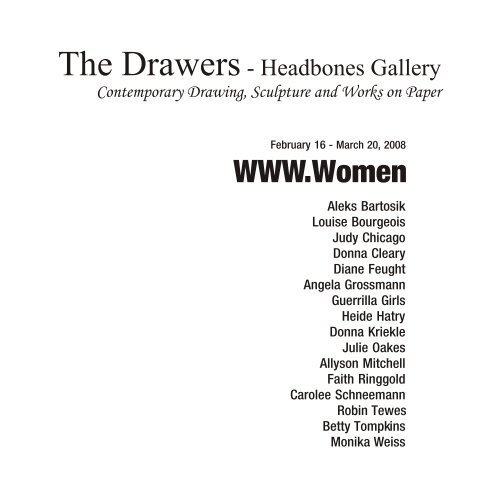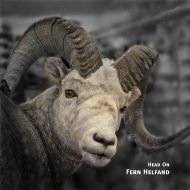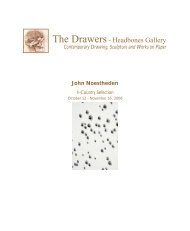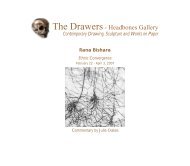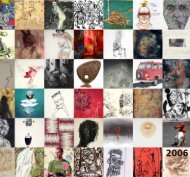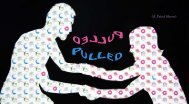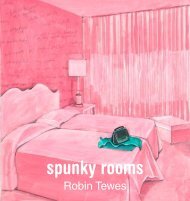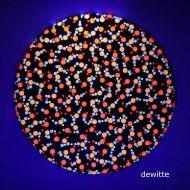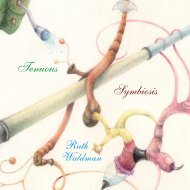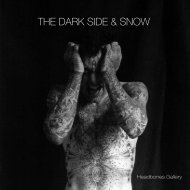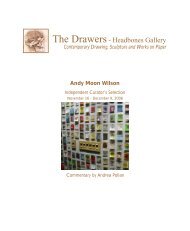Women Print Catalog - Headbones Gallery
Women Print Catalog - Headbones Gallery
Women Print Catalog - Headbones Gallery
You also want an ePaper? Increase the reach of your titles
YUMPU automatically turns print PDFs into web optimized ePapers that Google loves.
The Drawers - <strong>Headbones</strong> <strong>Gallery</strong><br />
Contemporary Drawing, Sculpture and Works on Paper<br />
Work’n It<br />
February 16 - March 20, 2008<br />
WWW.<strong>Women</strong><br />
Aleks Bartosik<br />
Louise Bourgeois<br />
Judy Chicago<br />
Donna Cleary<br />
Diane Feught<br />
Angela Grossmann<br />
Guerrilla Girls<br />
Heide Hatry<br />
Donna Kriekle<br />
Julie Oakes<br />
Allyson Mitchell<br />
Faith Ringgold<br />
Carolee Schneemann<br />
Robin Tewes<br />
Betty Tompkins<br />
Monika Weiss
WWW.<strong>Women</strong> - Copyright © 2008, <strong>Headbones</strong> <strong>Gallery</strong><br />
This catalog was created for the exhibition “WWW.<strong>Women</strong>”<br />
at <strong>Headbones</strong> <strong>Gallery</strong>, The Drawers, Toronto, Canada, February 16 - March 20, 2008<br />
Commentaries by Julie Oakes.Copyright © 2008, Julie Oakes<br />
Commentary for Julie Oakes by Ashley Johnson. Copyright © 2007, Ashley Johnson<br />
Artwork Copyright ©<br />
Aleks Bartosik<br />
Louise Bourgeois<br />
Judy Chicago<br />
Donna Cleary<br />
Diane Feught<br />
Angela Grossmann<br />
Guerrilla Girls<br />
Heide Hatry<br />
Donna Kriekle<br />
Julie Oakes<br />
Allyson Mitchell<br />
Faith Ringgold<br />
Carolee Schneemann<br />
Robin Tewes<br />
Betty Tompkins*<br />
Monika Weiss<br />
*Courtesy Mitchell Algus <strong>Gallery</strong>, New York<br />
Rich Fog Micro Publishing, printed in Toronto, 2008 - Layout and Design, Richard Fogarty<br />
WWW.<strong>Women</strong> sponsored in part by Candida Royalle’s Natural Contours<br />
All rights reserved. No part of this work may be reproduced or transmitted in any form or by any means,<br />
electronic or mechanical, including photocopying and recording, or by any information storage or retrieval<br />
system, except as may be expressly permitted by the 1976 copyright act or in writing from <strong>Headbones</strong><br />
<strong>Gallery</strong>. Requests for permission to use these images should be addressed in writing to the respective artist<br />
c/o <strong>Headbones</strong> <strong>Gallery</strong>. www.headbonesgallery.com<br />
ISBN: 978-0-9782458-3-2<br />
RICH FOG<br />
Micro Publishing<br />
Toronto Canada
Work’n It<br />
February 16 - March 20, 2008<br />
WWW.<strong>Women</strong><br />
Commentaries by Julie Oakes
Introduction<br />
<strong>Women</strong> can look at each other and see a reflection<br />
that adds up to a powerful, capitalised rendition of their<br />
gender for we have come into our own without having<br />
to resort to competitive wars over territory. <strong>Women</strong><br />
have generally acknowledged the maximum that “two<br />
heads are better than one”.<br />
The story of the final paring down of a candidate<br />
for a University teaching position illustrates the<br />
premise. Three women selected as finalists found<br />
themselves being asked to win the coveted position by<br />
Diane Feught - Wonderful, 2007-gouache, acrylic, rust on paper-20 x 17 inches<br />
stating reasons why the other women were not suitable<br />
for the job. They each began there defence by stating<br />
that they could see no reasons why the other women<br />
should not be chosen in their place. They had decided<br />
that they wouldn't gain ground by trampling their<br />
competitors. They elected to share the job and - to the<br />
great credit of this important institution - they had their<br />
desire for co-existence met!<br />
WWW.<strong>Women</strong> is built on such a premise. <strong>Women</strong>,<br />
long used to task sharing in order to overcome the<br />
rigours of childbirth, child rearing, gathering of food,<br />
maintaining shelter and the many chores that, born of<br />
necessity are best done by grouping together, bring<br />
their strength, brightness, intellectualism, capability,<br />
technical expertise and creativity to their art work.<br />
<strong>Women</strong> have maintained a dignity of gender in a<br />
profession traditionally the domain of men. The work in<br />
this exhibition exemplifies the fact that women have<br />
staked a self conscious claim within this nourishing<br />
field of dreams and in doing so broken ground that<br />
grew a different, female form of artistic avatar. Often<br />
political in approach, women have used their bodies,<br />
their intuition, their ability to nurture and multi-task and<br />
their grand operatic voices to shatter many a glass<br />
tower. In this Valentine month, WWW.WOMEN follows<br />
on the day of paper hearts and cliché promises in a<br />
spectacular show of solid womanhood with the female<br />
flag flying at full mast.<br />
During the opening, <strong>Headbones</strong> <strong>Gallery</strong> is hosting<br />
a baby shower for a new member to our feminine cast.<br />
Ivy Lumina Kurylowicz, born February 3 to Nancy and<br />
Martin Kurylowicz, will be welcomed into the circle of<br />
women, her mother's pregnancy celebrated and the<br />
male participation in it all, acknowledged and thanked.<br />
With an advocacy for inclusiveness, WWW.<strong>Women</strong><br />
commends the honourable and accomplished<br />
advantages of us all, regardless of gender.
Louise Bourgeois<br />
She is The Role Model of tenacity, endurance, and<br />
generosity of self and spirit. First trained as a<br />
mathematician, she switched and attended the Ecole<br />
Du Louvre and The Ecole Des Beaux Arts in Paris where<br />
she also worked as an assistant to Fernand Leger. She<br />
married an American and moved to New York City<br />
where she studied with the Art Students League of New<br />
York. Although she had been a vigorous practitioner of<br />
her art forms through out her life, it wasn't until she was<br />
in her sixties, (which was in the seventies) and after the<br />
deaths of her husband and father, that she achieved<br />
recognition. In 1993, she represented America at the<br />
Venice Biennale.<br />
Today, in the same house that she lived in with her<br />
husband, with a fading elegance topped by high<br />
shuttered windows that look onto a tangled garden that<br />
feels more like Europe than America; Louise continues<br />
to be a vital part of the growth of art. She hosts her<br />
Sunday salons where a small group of artists have one<br />
chance to visit the great artist and present what it is that<br />
they do. She doesn't appreciate return visits for she<br />
understands that her granting audience is an afternoon<br />
that many have veered towards and will continue to do<br />
so. It is indeed a privilege to be present as she teeters<br />
into the salon with the help of her walker. She nods and<br />
approves or with a slight wave of her hand signals for<br />
the next presenter. The company is international, men<br />
and women. Although on the treasured occasion of my<br />
visit, it was primarily women.<br />
This occasion is second only to the primary one -<br />
that of being in the presence of her work and this will<br />
endure long after her small time upon this earth. She<br />
has brought to light themes that have been at the heart<br />
of women's issues including incest, betrayal and<br />
childbirth. The etchings that follow relate to her<br />
adulterous father who had an affair with her governess,<br />
one that her mother refused to acknowledge. Best<br />
known for her cells and more recently her spiders, the<br />
great sculpture that rests outside of The National<br />
<strong>Gallery</strong> of Canada is titled Maman. The great role of<br />
matriarch is assigned to Louise Bourgeois.<br />
Untitled, 1994-Drypoint on paper-Image 4.5 x 6.5 inches
Birth, 1994-Drypoint on paper-Image 9 x 7 inches
Scissors, 1994-Drypoint on paper-Image 14 x 9.5 inches
Julie Oakes<br />
Existentialism teaches that experience is always<br />
modified in the telling; consequently, we are<br />
surrounded by fiction. Australian Aborigines value “the<br />
dreaming” over a fixed sense of reality and enjoy a<br />
multi-layered perception in which identity and<br />
objecthood are flexible.<br />
Julie Oakes’s exhibition “Conscientious<br />
Perversity” is a rich autobiographical narrative that is<br />
laden with metaphor. This is the last element in Oakes’s<br />
“Human Sacrifice” trilogy (comprising “The Quercia<br />
Stories,” “The Revolving Door” and “Conscientious<br />
Perversity”), which draws on libertine adventures and<br />
different ways of exploring sexuality as a woman. The<br />
main characters are the siblings Juliette and Justine<br />
Quercia, alter egos of the author borrowed from the<br />
Marquis de Sade. Juliette serves as a foil for the more<br />
libidinous Justine.<br />
Although the works have titles corresponding to<br />
chapters in a book by Oakes, they are not strictly<br />
illustrative. Indeed, the writing often seems painterly,<br />
with expressive metaphors piled up like vehicles in a<br />
traffic jam. The artwork is metaphysical and packed<br />
with humorous undercurrents that are manifested<br />
through cartoonish simplification. Thus the hapless<br />
donkey held upside down for a sex act in the colourful<br />
story of an incident in a Mexican bar makes numerous<br />
appearances. The repeated appearance of the artist’s<br />
trademark orange bob hairstyle (even worn by the<br />
donkey in Ludicrous Strangeness) alerts us to the fact<br />
that these are self-portraits.<br />
There is a beguiling menace in these works, like a<br />
female spider about to devour her mate in the act of<br />
making love. A delicate, feminine sensuality is<br />
embedded in the web of imagery with the inclusion of<br />
lingerie or exposed limbs. Clairvoyant third eyes peer<br />
through various orifices and negative spaces,<br />
observing the voyeur. Hilarious silhouettes burst into<br />
life and dash across the works’ surfaces, frantically<br />
trying to lose clothing. Carcasses of dead animals<br />
become energized again.<br />
The fervid atmosphere is passed on to the viewer,<br />
giving one the sensation of entering a whirling mass of<br />
imagery. It is an illusion, however; the works are<br />
disciplined, with certain forms echoing throughout.<br />
Oakes uses dissonance: virulent crimson tones abut<br />
oranges and maroons with an occasional startling blue.<br />
The inversions of scale conjure a scene reminiscent of<br />
Dante’s Inferno.<br />
Canadian Art -In Review, Spring 2007 Vol. 24 No.1<br />
by Ashley Johnson<br />
At The Stake, charcoal and ink on paper, 60" X 44", 2006
Cunte-Video, glass sculpture, limited edition hard cover, signed novella Conscientious Perversity
Ludicrous Strangeness, charcoal and ink on paper, 60" X 44", 2006
Glassy Eyes, charcoal and ink on paper, 60" X 44", 2006
Carolee Schneemann<br />
Fresh Blood A Dream Morphology, 1983-2004-Photo, color 15/15-40 x 60 inches<br />
The words 'risky' and 'brave' are often associated<br />
with Carolee Schneemann's work. These adjectives<br />
poke into the core of the apple, that forbidden fruit that<br />
Eve first offered to Adam, the apple that had the slight<br />
perfume of fear to it's ester, the sense of a higher<br />
authority lurking in the wings, spying on the sex. After<br />
all, there were repercussions to the bite; God asked<br />
Adam and Eve to leave paradise, an embarrassing<br />
scene where shameful, original sin had been<br />
committed (with Eve probably weeping and Adam<br />
kicking himself for having fallen for her seductive<br />
ways). Eve was cast as the temptress for although<br />
women might have been socialised to behave<br />
otherwise, they're not all sugar and spice. <strong>Women</strong> can
e wild, have a propensity to become hysterical, and<br />
possess an intuitive psychic response to unseen<br />
forces.<br />
Schneemann began as a painter - always drawing<br />
- and yet also underpinning her work with the written<br />
word. She emerges just as happenings were coming<br />
into being, using her body to draw in as well as mitigate<br />
what might have been an even more shocking<br />
spectacle had she not been so beautiful. In a time when<br />
feminist mores were turning to 'sensible' shoes and<br />
unshaven legs, she was riding on Robert<br />
Rauschenburg's neck, buff naked, glorious and<br />
glamorous.<br />
The history of art has sustained few women artists<br />
but those who did surface to float in view alongside the<br />
more demonstrative males were exceptional and also<br />
in their own way, wild. Artemesia Genteleschi, for<br />
instance, took the case of her sexual abuse at the<br />
hands of her painting teacher who was also her father's<br />
assistant, a man his age - to court. Her subjects were a<br />
herald of female emancipation, such as Judith<br />
chopping off the head of Holofrenes - a brave symbolic<br />
act. There were the colorful, exceptional women who<br />
lived with the men of the West Bank in Paris and were a<br />
vital part of the mileu; Sonia Delauney who married<br />
Robert Delauney and Suzanne Valadon, Maurice<br />
Utrillo's mother who in 1894 was the first woman<br />
painter admitted to the Société Nationale des Beaux-<br />
Arts. A perfectionist, Valadon worked on some of her oil<br />
paintings for up to thirteen years, before showing them.<br />
There were women working as artists, once the<br />
research was done to find them, and Judy Chicago's<br />
Dinner Party with her memorial plates to female artists<br />
brought a lot of those names to the fore.<br />
Carolee Schneemann speaks of the unspeakable<br />
side of women, the un-demure. Interior Scroll<br />
performed in 1975 related a conversation between<br />
Interior Scroll, 1975-2003-Photo, color 15/15-40 x 60 inches
herself and “a happy man, a structuralist filmmaker”.<br />
The text was a documentation of irreconcilable<br />
inequality between the sexes. She read the narrative<br />
from a folded paper that she had inserted into her<br />
vagina, drawing it out, inch by inch, her body in an<br />
unflattering half crouched position. In the text, she<br />
brings to his attention the work that she, herself, had<br />
done as a filmmaker. He counters her offering of her<br />
credentials by refering to her as a charming woman,<br />
“We think of you as a dancer,” is his assessment of her<br />
filmmaking efforts. Schneemann's take on the story<br />
was brilliant. She drew forth, from her mysterious<br />
complex womanhood, the story of an unflinching<br />
refusal to see the woman as artist. “He said that we<br />
could be friends equally but that we are not artists<br />
equally”, she read. Then she read her reply, “We cannot<br />
be friends equally and we cannot be artists equally”.<br />
The final words that she read (his) “We think of you as a<br />
dancer”, spoken as she drew forth the last of the long<br />
interior scroll; made it's point.<br />
Meat Joy with the near naked men and women<br />
activating contact improvisations using sausages,<br />
paint, fish and raw chickens brings out this same<br />
irresitible inclination to tell an intuitive truth. Foucault<br />
relates to the idea of daimon, that part of mankind that<br />
reveals the chaos within and it is by knowing this<br />
daimon that we are able to shed the borrowed manners<br />
that come with our social conditioning and truly get to<br />
know what we consist of. This is a dangerous idea for it<br />
involves an awareness of the boundaries of<br />
acceptability and that becomes a personal delineation<br />
that might not fall within the realms deemed 'normal'. It<br />
is the principal of the avant garde, an advanced group<br />
that goes to the outfields of the discipline.<br />
Schneemann's work hovers around the outfield,<br />
lingers on the borders. It is truly unorthodox and<br />
experimental.<br />
Schneemann approached the borders between<br />
the human and the animal. She accepted the ardent<br />
kisses of her cat over the course of eight years. She<br />
filmed the daily kisses of this persistent event<br />
producing a time factored photographic grid in which<br />
the agency of the pet cat becomes an erotic delirium.<br />
In Terminal Velocity (2001), she structured<br />
enlarged photographic sequences of people falling<br />
from the twin towers, plunging to their death. Pushing<br />
the boundaries, once again, but this time sexuality is<br />
not the issue. But the question “What is decent?” is still<br />
there. Schneemann has put herself out there. She has<br />
not done anything vicariously. She has been there<br />
herself, making the plunge with the air singing around<br />
her and a “break on through to the other side” awaiting.<br />
She has been a brave artist.
Water Light/ Water Needle, 1966-2003-Photo, color 15/15-40 x 60 inches
Donna Cleary<br />
At one time, children meant the continuance of the<br />
tribe. Birth was a natural process but so also was death<br />
and the survival rate was not as secure as in the<br />
western world in modern times. Fertility figures were a<br />
common artifact, a necessary prayer or good luck<br />
omen towards the continuance of life. In some cultures,<br />
these artifacts were worshiped, even elevated to a God<br />
or Goddess like status. When male, the figurines or<br />
statues would often sport erect phalluses. When<br />
female, it was not the genitalia that was glorified, as<br />
much as the state of gestation. Pregnant women with<br />
milk filled breasts symbolized bounty, prosperity and<br />
good fortune.<br />
Modern western culture is proportionately bereft<br />
of fertility figures. In fact, with the population still<br />
growing, it could be accused of holding a somewhat<br />
jaded view of childbirth. The pressures of modern living<br />
have necessitated double income families and the ‘job’<br />
of rearing the child can be farmed out to care facilities.<br />
Family time has, sadly, been shortened and the term<br />
‘family values’ has an undertone of suspect political<br />
positioning that is quite often adverse to the natural<br />
concept of family.<br />
Who then, is culturally elevating the pregnant<br />
women? As ever – artists. Both male or female, once hit<br />
with the indelibly magical circumstance, they celebrate<br />
their engagement in the process with as much<br />
fascination as if they were the first ones to ever produce<br />
a baby. The birth of a child is indeed marvellous and the<br />
anticipation of the marvel is held within the physical<br />
aspect of the pregnant body. Pregnant women still<br />
garner the emotional response of compassion, their<br />
swelling bellies being patted, rubbed and listened to.<br />
Always a clear symbol of the bounteous and<br />
beautiful, the pregnant body, nude, is glorified in Donna<br />
Cleary’s drawings and monoprints. To omit, in an<br />
exhibition that celebrates women, imagery pertaining<br />
Monoprint #10,#17,#23, 2007-10.5 x 8 inches<br />
to the solely exclusive female state of pregnancy,<br />
would be close to a slight to the gender. <strong>Women</strong>,<br />
capable of being ‘with child’, are hence the ones who<br />
know best how to visually speak of the experience.<br />
Donna Cleary represents the natural phenomena well.
Heavy, 2007-Pencil on paper-40 x 30 inches
Signed Guerrilla Girls Poster- 27 x 11 inches
Monika Weiss<br />
Although there is an invitation to look at the curled<br />
body, the identity is not revealed. The presence of<br />
humanity is denied, manipulated away from the one<br />
who is watching by the artist who had originally<br />
extended the invitation to look by placing the image on<br />
the paper, within the framework of an exhibition space<br />
and the overall context of creating art. This seduction<br />
to participate, having been denied the consummation<br />
of fully knowing and hence understanding, is much like<br />
the dichotomy of the human condition, whereby life is<br />
granted with awareness in varying strengths, but the<br />
reason for the gift is unexplained. It is the blind spot of<br />
Derrida, that understanding in the mind of the<br />
existence, but not being able to keep the knowledge<br />
and the experience in the field of immediate vision.<br />
Like a wintry day when freezing temperatures lead<br />
the inclination to burrow into the warm envelope of<br />
hearth and home, the figure wraps upon itself. As in the<br />
womb or sleeping in cosy seclusion, the figure turned in<br />
upon itself, signals privacy and introversion. Yet the<br />
display of the body is extroverted. Weiss has used her<br />
corporeality as the basis for her mark making, drawing<br />
around her crouched position, tracing the outline of her<br />
body. She is realising her shape as she draws, but she<br />
cannot see it until she moves and looks back upon the<br />
paper. It is this distance from her habitation of the flesh<br />
that creates the necessary objectivity towards her<br />
being. It is a philosophical perspective, a logical<br />
rationality placed upon the immediacy of being<br />
present. As if she has managed to step away from her<br />
shadow or to rise above her frame in an out-of bodyexperience,<br />
the artist has been able to 'be' in two<br />
places at once - both within her body and viewing it. By<br />
inserting the performative, a more modern practice,<br />
into the traditional borders of drawing, the<br />
representation of the self encompasses the time<br />
dimensions - the present, the future life of the piece and<br />
the past as she steps away from the active practice<br />
where body and mark making have coupled.<br />
Rigorously intellectual, the work of Monika Weiss<br />
recreates the illusion of omnipotent dimensional<br />
manipulations of both time and space as it moves from<br />
point to line to the illusion of a third dimensional reality.<br />
<strong>Women</strong> who use their own bodies as the image<br />
within their art expose themselves in a public way while<br />
leaving themselves as they inhabit their body. They<br />
become open to critical attention and comment. Weiss<br />
is not a blatant exhibitionist. She strikes a balance<br />
between presence and absence, revelation and<br />
concealment, body and mind (as the element<br />
exposed), art practice and bodily practice. With one<br />
foot in the traditional - she is an accomplished and<br />
expressive drawer - she also straddles the river of ideas<br />
and stretches the limits of the discipline by drawing<br />
with her entire body.<br />
Ennoia, 2004-Limited edition photograph-28 x 36 inches
Urlar 1, 2007-Graphite, pencil, charcoal, archival glue and found images-39 x 36 inches
Urlar 3, 2007-Graphite, pencil, charcoal, archival glue and found images-39 x 36 inches
Urlar 2, 2007-Graphite, pencil, charcoal, archival glue and found images-39 x 36 inches
Miniature 27, 2007-oil on photo, 3 x 2 inches
Angela Grossmann<br />
Current reality is a series of overlays on the past<br />
and the separation between the tenses is dependant<br />
on the conceptualisation of them. It is this overview of<br />
time and imagined space, alongside the rational<br />
capacity to anticipate that places us in the liminal<br />
position - on the threshold of knowledge, away from<br />
the beasts. Angela Grossmann depicts this wavering of<br />
tenses with her paintings on photographic images<br />
taken from the turn of the century. That she overlays the<br />
remnants of the past with images that can transmit a<br />
sensational message straight to the libido grants a<br />
dynamic to the work that is evermore poignant than the<br />
Miniature 14, 2007-oil on photo, 3 x 2 inches<br />
always present realisation that without effort, time is<br />
passing. Part of the appeal to the senses is derived<br />
from the handling of the paint. It signals the presence of<br />
a free hand, a self referential, libidinous messiness, a<br />
relish in the sensuality of paint.<br />
Beauty is fleeting and the depiction of the world of<br />
beauty is an attempt to unfasten beauty from the<br />
embrace in the passage of time. This has been the<br />
subject of convoluted philosophical treatises that turn<br />
back into themselves in the ambitious task of pinning<br />
down what might be described as an allure<br />
comparable to an aura - outside of the subject,<br />
emanating from the matter and overriding the<br />
temporal. It is this elusive aura that is depicted in<br />
Grossmann's work and she does so by using the<br />
medium with metaphorical advantage. A drip, for<br />
instance, as it wanders leaves a trace in time, so does a<br />
spatter. The gestural application of paint speaks of a<br />
presence before solidification of the art work - that<br />
which becomes the arrested object. When energy is<br />
fastened to the object by way of the art making, there is<br />
room for desire to enter, an element of beauty.<br />
Grossmann, herself, could be described as an<br />
Alpha Girl (the title of a series by the artist made in<br />
2004) for as one of the Young Romantic Painters, she<br />
entered the art scene as the girl amongst titans and had<br />
no trouble keeping up with the boys. With a dextrous<br />
hand and facile bravado she created a 'look' that made<br />
her dripping young women into 'it girls' - saucy, cheeky<br />
and self assured even in the midst of tears or a nervous<br />
breakdown. Her figures embody the range of human<br />
emotions, pathetic to pithy, that embody everything<br />
that the title Young Romantic Painters could have<br />
hoped to invoke. Lounging superbly in attitudes gothic,<br />
gauntly adolescent, and egotistically whimsical;<br />
Grosmann's figures capture all of the highs and lows of<br />
yearning for impossible beauty.
Miniature 13, 2007-oil on photo, 3 x 2 inches
Miniature 17, 2007-oil on photo, 3 x 2 inches
Judy Chicago<br />
Although Georgia O'keefe had painted flowers<br />
that were suggestive of vaginal imagery, it wasn't until<br />
Judy Chicago and The Dinner Party that female<br />
sexuality found due attention in the echelon of<br />
acceptable subjects for the attention of the visual arts.<br />
Adopting art forms taken from the womanly crafts<br />
(china, painting, needlework and ceramics),<br />
she rallied the support of helpers and made a project<br />
that was beyond the accustomed scope of female,<br />
certainly, and even most male precedents. It was a<br />
starting point, the avant garde step that set women into<br />
great stride and Judy Chicago, as well, not only kept<br />
pace with her first glorious stepping-out but<br />
superseded herself with other work such as the Birth<br />
Project and the Holocaust Project. The resounding<br />
confirmation that she is indeed The Avatar is in the<br />
work.<br />
It is fitting that the suite of prints from the Birth<br />
Project should be part of WWW.<strong>Women</strong> and that her<br />
definitive imagery and energy should stand beside<br />
many successful women artists whose work has been<br />
influenced by Judy Chicago in one way or another.<br />
<strong>Print</strong>ed in 1985, when the technical rigor of serigraphy<br />
meant that the stencils were applied by hand, rather<br />
than photographically adhered to the silk as they are<br />
often made today, the prints are adept and flawless in<br />
execution. The shading, done with a stippled touch<br />
creates voluminous folds and curves much like a heavy<br />
set airbrush. The soft modelling is sensuous. The paper<br />
itself has been lifted from inclemency to become a<br />
lively presence, radiating self assurance and confident<br />
femininity. Chicago has reclaimed the subtle,<br />
reaffirmed the curve, opened the center and bloomed.<br />
To see the work that was made twenty years earlier, as<br />
vibrant and seductive as ever, from the hand of an artist<br />
who has been held as an iconographic figure in the art<br />
world, still as beautiful as ever, inspiring the desire to<br />
possess - is a heartening affirmation that the place<br />
women have managed to secure in the arts is not only<br />
blossoming but managing to maintain a full bloom.<br />
Judy Chicago, to many women artists, has been<br />
the grand dame of contemporary art because she<br />
organised art projects such as The Dinner Party and<br />
the Birth Project that went way beyond the size<br />
limitations and ambitions of women artists previous to<br />
her. She has inspired artists and artisans to feed their<br />
expertise into her visionary overview while granting an<br />
enabling legacy to the following generations of women<br />
artists.<br />
Ceramic Goddess #11, 1977-Bisque, mounted in frame with plaque-From the Dinner Party-9 x 7 x 3 inches
Earth Birth, 1985-Serigraph on black paper, Edition of 75; 34/75-24 x 35 inches
Birth Trinity, 1985-Serigraph, Edition of 75; 34/75-24 x 35 inches
Guided by the Goddess, 1985-Serigraph, Edition of 75; 39/75-24 x 35 inches
Creation of the World, 1985-Serigraph on black paper, Edition of 75; P. Proof-24 x 35 inches
Birth Tear/Tear, 1985-Serigraph, Edition of 75; 34/75-24 x 35 inches
Betty Tompkins<br />
Cunt Grid #6-Stamp on paper-14 x 11 inches<br />
Big, strong, aggressive imagery, indecorous<br />
subject matter, explicit content - all words that<br />
describe a phallic centric orientation. Tompkins<br />
redresses a subject, one that had been a specifically<br />
male point of view and does justice with a female<br />
perspective on the same issues.<br />
Standing up to the possibility of being deemed an<br />
'unwomanly woman', she takes the initiative and<br />
directs her gaze and hence her attention upon the act<br />
of copulation. Referring to French philosophical<br />
writings on the gaze, this is a male attribute. When the<br />
object is seen or captured by the gaze, the<br />
consummation of the male gaze upon the object takes<br />
place.<br />
She chooses a technique that distances herself<br />
from a tactile involvement in the rendering. Take the<br />
drawings, or paintings, where the mark has been made<br />
by stamping a word or a number of words, over and<br />
over again so that they form a crosshatching on the<br />
pristine white paper and model the subject matter. The<br />
word itself - speaking out - is seated firmly within the<br />
male realm as it is a didactic, outgoing expression of<br />
self, as opposed to the female 'listening' position. On a<br />
closer inspection of Tompkin's renditions of this very<br />
private, intimate act, the words used to render the<br />
figure become clear. It is, in this instance 'cunt' and<br />
'cow' repeatedly stamped so that the words form the<br />
pubis and vaginal lips.<br />
Betty Tomkins could be called a feminist<br />
philosopher for she has taken on an issue that is not<br />
traditionally familiar to women - the close scrutiny and<br />
subsequent depiction (blown hugely out of scale) of the<br />
sex act. It is an unflinching call to attention. Gustave<br />
Courbet's painting The Origin of the World made a<br />
frank statement that the human species all passed<br />
through the woman's sex on their way in to this world.<br />
Cunt Grid #2-Stamp on paper-14 x 11 inches
Cunt Grid #1-Stamp on paper-14 x 11 inches<br />
Tompkins traces the origins of the world back further to<br />
the pro-creational duality. It is not the woman's genitals<br />
alone that are the source of birth. The genital union<br />
between the male and the female is the source.<br />
Perhaps Courbet was saying that the sight of the<br />
female, as the object captured by his gaze, is the<br />
provocation for the eventual act of sex that will let loose<br />
the sperm and fertilise the egg? Tomkins is explicit.<br />
Human life is the result of a grand and momentous<br />
moment. And humans also have the extra bonus of<br />
experiencing pleasure with no other end in mind than<br />
the 'boink' (another Tompkins stamp).<br />
There has been a massive politicisation of the<br />
ways we have become accustomed, and allowed to<br />
view sex, especially for women who have been<br />
historically 'protected' from seeing the sex act. After<br />
all, biologically, it is difficult for a woman to see herself<br />
having sex without the help of a mirror. Men can have<br />
sex and watch.<br />
It took a feisty woman to monumentalise the<br />
genitals, using the popular vernacular ('cunt', 'cock',<br />
'fuck') in the titles in place of the clinically correct<br />
terminology, and to come up with a handsome product<br />
in doing so.
Dick Grid #2-pencil on paper-14 x 11 inches<br />
Cunt Grid #8-pencil on paper-14 x 11 inches
Faith Ringgold<br />
<strong>Women</strong> of color have had to address an expanded<br />
platform in terms of their gender because of the long<br />
history of abuse, discrimination and superficial<br />
categorizations of their race. There could also be a<br />
valid argument that where white women have had to<br />
challenge the hierarchical inconsistencies between<br />
male and female in order to gain a secure footing in Fine<br />
Arts, women of color have had the added challenge of<br />
overcoming stereotypical translations of gender that<br />
have been perpetuated concerning their particular<br />
racial backdrop. All women who have managed to<br />
stand at the forefront of the art world are to be<br />
applauded but the women of colour who have<br />
managed to do the same, deserve a standing ovation.<br />
Not only have they had to overcome gender and race<br />
prejudice but they have also been operative in bringing<br />
people of colour into view. Fine Arts has always been<br />
an opportunity to pay tribute to ideas and record<br />
history, which can be easily discerned through a quick<br />
scan of western art and civilization. But the story of<br />
people of color has not been put forward with the same<br />
insistency. Faith Ringgold is visually speaking of her<br />
people and is filling the spaces denied her people in the<br />
books of yore with new and vibrant pages.<br />
With a philanthropic and compassionate personal<br />
history of charitable and social actions, she has gained<br />
the admiration and respect of those who came in<br />
contact with either her or her proxy - her art. She has<br />
used both the written word as well as the visual realms<br />
to put forward the particular advantages of her African<br />
Americanism. Ringgold's sure hand provides a quick<br />
graphic read, similar to the clear pop imagery of<br />
Warhol, yet it is seated in a different premise. Rather<br />
than accelerating a case for the celebration of culture<br />
as we live it in the world of popular commodities,<br />
Ringgold tells of the cultural specificity of people of<br />
color.<br />
Jazz Stories, Mama Can Sing 2001-04-Acrylic on Paper- 19.5 x 13. 5 inches - 2/9<br />
The dreadlocks on the woman in “Mama Can<br />
Sing” spring from her head like a fountain of glory. She<br />
is as black and glamorous as the nightlife of Harlem.<br />
Ringgold, herself holds the stature of a queen and,<br />
dressed in African styling with her own magnificent<br />
head of dreadlocks, she poses a commanding figure.<br />
Her regal dignity carries through with soulful energy<br />
into her art work. She has become a respected master<br />
(gender non-specific), not only as a female artist but<br />
also ringing loud and clear with her clarion cry for black<br />
women.
Jazz Stories, Mama Can Sing 2001-04-Acrylic on Paper- 19.5 x 13. 5 inches - 8/9
History of the World, 2001-Pencil on paper-29 x 23 inches
Robin Tewes<br />
Robin Tewes has been on a dogged pursuit of<br />
understanding with a Zen persistence that interprets<br />
her research with the simplicity of a Koan. As in a Koan,<br />
the original question posed has an element of the<br />
nonsensical and yet the answer is an illumination. What<br />
makes up the domestic environment? Since the rooms<br />
that Robin Tewes draws represent an interior where the<br />
majority of North American women spend their days -<br />
the furniture is mid-range, even the size seems 'normal'<br />
- and noticing that she has drawn and painted these<br />
typical spaces for years - what has her search<br />
revealed? The pieces speak the answers in the<br />
Fuck me, Fuck you, 2000-Pencil on paper-29 x 23 inches<br />
aberrations from normality that occur within the picture<br />
frame, like a message read between the lines or a<br />
subliminal voice-over.<br />
To have recorded these spaces connotes that she<br />
has observed and documented them. Has she<br />
invented rooms, or are they rooms remembered where<br />
the details are specifically tied to impressions that were<br />
large enough to leave a mark on her consciousness?<br />
The insignificant details would have faded away so that<br />
the import of the room leapt forward and assumed the<br />
attention. To read the messages scribed on the walls<br />
(or in an instance on a table top) requires an attention to<br />
detail. Often the words have been written and then<br />
erased as if the significance of the message is not<br />
worthy of being viewed or, if it is a visual, the<br />
relationship to the environment is tangential as in the<br />
ink blot images. A timorous stance has been taken to<br />
the intrusive presence. It is revealing and necessary to<br />
spend the time reading, for this is not a loudly<br />
proclaimed declaration of being. The walls are<br />
whispering. What do they whisper? They say that they<br />
have forgotten something, they ask why he is always<br />
late, they list the groceries and they talk about art. At<br />
the same time as the Cy Twombly-like scribble<br />
registers, the words themselves communicate the<br />
artist's thoughts about her discipline.<br />
Within quiet domestic environments, aesthetically<br />
arranged, chosen with a particular eye for order and<br />
cleanliness, in the intact, pristine expressions of place -<br />
Robin Tewes is firm and exact in her presentation of her<br />
world. She turns the potential to be picayune, the<br />
nonsensical aspect of her Koan, into a dignified<br />
illumination. It is the skew in the picture that heightens<br />
the revelation - the scribbled insistent messages, often<br />
confused and muddled like the niggles of things lost or<br />
a reminder to focus - on art, on love, on anything<br />
outside of the perfect pristine, seemingly normal, room.
Down the Drain, 2006-Gouache on paper-29 x 23 inches
I'm a Good Listener, 2002-Gouache on paper-29 x 23 inches
Donna Kriekle<br />
“One in nine women!” Whenever the statistics are<br />
high, the shivers set in. The fight against breast cancer<br />
has been engaged with a vehemence and strength<br />
equal to the laborious act of giving birth. Kriekle's<br />
video, originally commissioned for "Survivors, In<br />
Search of a Voice: The Art of Courage", is titled If I Were<br />
to Need a Mastectomy... It is a poignant piece and, for<br />
some, may be difficult to watch but due to Kriekle's<br />
compassionate nature and video acumen, it is a<br />
heartening experience as it encourages hope while<br />
demystifying a delicate subject.<br />
Kriekle explains in the catalogue that<br />
accompanied the original exhibition. "On the issue of<br />
breast cancer, it is a table of contents. As we gather<br />
around this cancerous table of chance, each of us<br />
becomes a player, either as spectator or as a<br />
participant. What are the odds?”<br />
With the cult of the breast growing in numbers and<br />
size as implants have become a more common<br />
cosmetic choice, the shape of a woman and the glory<br />
of her breasts are as ever, a cause for wonder. The loss<br />
of a breast due to cancer is as traumatic for the self<br />
esteem as it can be for the physical well being of the<br />
woman. Breast cancer research has made the<br />
diagnostic process and the subsequent examinations,<br />
biopsies and surgery less intrusive and painful but the<br />
subject itself, particular to women, continues to stymie<br />
the afflicted and provoke concern. It is more than a<br />
worthy subject for cultural research and subsequent<br />
interpretation. Kriekle's take on the matter touches the<br />
heart.<br />
Language - Iris 2003-watercolor on arches paper-11 x 30 inches (rotated 45 degrees)
If I were to Need a Mastectomy, 1994-Video, approx. 5 minutes
Still from Expectations, 2007-Video, 3 minutes, edition of 5
Heide Hatry<br />
The British show Sensation contained art works<br />
that were sensational. The word 'sensation' is<br />
described as “a mental process that is due to<br />
immediate bodily stimulations as distinguished from<br />
perception”. ‘Sensational' is described as often<br />
pertaining to the lurid - quick, intense and, sometimes,<br />
superficial. When the perception stimulates the<br />
sensation and in doing so triggers a mental response, it<br />
awakens cognisant connections that further that<br />
immediate reaction. Heide Hatry's work with blood, for<br />
instance, can be associated with the luridus realms of<br />
death and provoke a reaction akin to having witnessed<br />
a murder. A shiver runs up the spine, a step is taken<br />
away from the spectacle and an expression of awe<br />
emitted. It is because there has been 'blood let'. For<br />
example, Hatry, dressed in a chic, short white wedding<br />
gown, skinned a pig in one of her performances. She<br />
ended up covered in blood, the beautiful white garment<br />
gradually stained a deeper red over the course of the<br />
performance. Awful! - 'awe full', and yet blood is also a<br />
traditional element of matrimony. The hymen is broken,<br />
the sheets hung out for inspection and until the egg is<br />
fertilised, the woman bleeds each month.<br />
Hatry has captured herself on video as she 'lays'<br />
an egg. In one instance, she is nude, covered with dirt<br />
and the scene is set in nature. This is the 'wild' woman<br />
who perceives the event is nearing and quite naturally<br />
from her vagina, the lips swelling as they release her<br />
bounty - an egg is laid. In the second video we see a<br />
smart, seemingly sophisticated woman (the artist) in<br />
business attire - although the skirt is very short and the<br />
legs very long and bare - carrying a shiny silver laptop.<br />
She, too, 'lays' an egg and then ends the dynamic<br />
performance dramatically. Much like a movie review, it<br />
is better not to tell the ending for it is worth not knowing<br />
the ending in order to catch the sensation from the<br />
initial viewing of the piece. Once again awe! Hatry has<br />
created an art work that causes a reaction in the<br />
senses. It is not solely a sexual reaction, although this is<br />
not to be ignored for it is titillating to watch a woman<br />
push an egg out. It is more than a pornographic<br />
response, however. It provokes a sense of wonder at<br />
the connection having been made between the idea<br />
and the physical enactment of it. It is a mental<br />
placement of oneself in relation to the artist - “she did<br />
that! Could I?”<br />
Is there that great a difference between standing in<br />
front of any phenomenal art piece? An early Bellini,<br />
Botticelli's Venus, Picasso's Guernica, Gericault's Raft<br />
of the Medusa,a large Jackson Pollock drip painting,<br />
Judy Chicago's Dinner Party, all of the phenomenal art<br />
works that cause the “wow!' reaction. Are they not all<br />
based on a sensation?<br />
Heide Hatry is one of those women who run with<br />
the wolves. She expostulates against the prim and<br />
brandies a new essentialism, a credo that<br />
acknowledges the primal, that celebrates basic<br />
instincts and expands the notion of femininity. She<br />
does this with her body, and with fit, sexy assurance<br />
turns heads at the outset, using her female allure to<br />
gain attention. Then she grants a peak at something<br />
beyond the pale of the more discretionary set. With<br />
video, photography and sculpture coalescing her<br />
conceptually avant-garde subject matter, she offers a<br />
fresh take on the 'gentler sex'.
Egg Birthing #1,2,3,4,5,6-Photos, color, 24 x 20 inches
Stills from Expectations, 2007-Video, 3 minutes, edition of 5
Eggs in the Box-photo, b&w, image 9 x 7.5 inches
Allyson Mitchell<br />
Helena, 2005/06-Mixed media sculpture-Length 34.5” x Width 11” x Height 10.5”<br />
Little girls are surrounded by the pink fuzziness of<br />
stuffed animals. Bedded down with them, they<br />
ritualistically line their cute furry bodies up in an order<br />
that works before closing their eyes, now safe to sleep.<br />
Carrying them around like little babies, dressing them<br />
up, combing their hair and grooming their inanimate<br />
bodies, they can become closer than real friends, a<br />
quietly sympathetic and non-judgemental ear for<br />
secrets yearnings. Many women, grown and way past<br />
puberty, still decorate their beds, armchairs and<br />
dressers with dolls and cuddly animal surrogates that<br />
range from pussy cats, through the more seemingly<br />
masculine teddies and puppies to the grand queen of<br />
the beasts - plush, and often royally expensive, lions<br />
and tigers. They are the first fetish objects of childhood.<br />
They signify a more innocent hierarchy of attachment<br />
than the adult has to contend with as life becomes<br />
complex and rife with the pressures of social<br />
awareness and emotional attachments.<br />
The magic of the myth of the Sasquatch is partially<br />
embodied in the unattainable. 'Sasquatch' even roams<br />
outside of the net of spell check. Never verified as a<br />
'real' animal, rumoured to be shy yet big (and usually<br />
homely), they trudge the woods, staying clear of the<br />
misguided attention of humans. They are hairy<br />
mammals, elusive and unable to be captured, even on<br />
film although there are many claims to their virtual<br />
existence. Allyson Mitchell has placed her own version<br />
of their physicality on the bulky beast giving them a<br />
face, a sense of warmth and endearment. In claiming<br />
the responsibility of having captured the sasquatch,<br />
she has also proclaimed discovery. The sasquatch is
Gretchen, 2005/06-Mixed media sculpture-Length 6.5” x Width 4” x Height 7”
Carla, 2005/06-Mixed media sculpture-Length 12” x Width 6.5” x Height 6.5”<br />
Paula, 2005/06-Mixed media sculpture-Length 7.5” x Width 4” x Height 5.5”
Jade, 2005/06-Mixed media sculpture-Length 3” x Width 7” x Height 11”
female! Much like the Amazons, her sasquatch has no<br />
need for men. They have figured out the secret of selflove<br />
and in doing so have established a strong self<br />
esteem. No need for the interaction with the more<br />
polluted tribes of human descent, they roam the same<br />
planet, free of technological constraints, not<br />
experiencing the discontents of modernity but instead<br />
enjoying the enlightened moments of females<br />
interacting with females. The smaller pieces are<br />
sasquatch familiars who live near and around the large<br />
giantesses. When they are in the same space together<br />
it is unclear who is protecting whom - the giant<br />
"hideous" monsters or the tiny feminized pink and<br />
more domesticated familiars. This is the narrative that<br />
speaks from the fuzz clad bodies of Mitchell's<br />
sculptures. She has managed to provoke a welling up<br />
of compassion for her sculptures. Mitchell has<br />
reclaimed cute, sweet, soft, and even pink all in a<br />
sweeping gesture of acceptance.<br />
Her statement is a lesbian propagation of the<br />
sensibility of identification of women towards women.<br />
She proclaims the light side of the mysterious animal<br />
nature of the female. Mitchell's work takes the<br />
proactive stance of gay rights into an arena where the<br />
distancing of myths is brought closer in order to<br />
comprehend the drama unfolding between the sexes,<br />
as well as between the animal and the human. And<br />
through the use of synthetic plush and fake furs, she is<br />
also bridging the narrowing gap between art and<br />
popular culture.<br />
G.B., 2005/06-Mixed media sculpture-Length 28” x Width 10” x Height 9”
(above) Hairy Girl, 2001-conte, charcoal and oil stick on paper-100 x 60 inches<br />
(left) My Friend and I, 2001-conte and oil stick on paper-100 x 60 inches
Aleks Bartosik<br />
These are provoking drawings, rebellious stances<br />
that push the unconventional. They are pugilistic with<br />
the boxing gloves loaded - clenched fists ready to<br />
punch. They're masochistic and appeal to the sadistic<br />
side of the psyche, that unacknowledged cry to be<br />
beaten and receive the full brunt of nastiness and<br />
humiliation. Aleks Bartosik reconciles the opposites of<br />
human grossness and glamour with the dramatic<br />
brashness of size and theatrical composition. Primarily<br />
focusing on the female figure, she creates situations<br />
that suggest a tangential perversity. None the less,<br />
there is a sexy allure and it is in this respect that the<br />
unconventional comes into play. They appeal to the<br />
fascination of a big naughtiness like a Roman<br />
overindulgence that is so over-the top that it is destined<br />
to implode but tastes delicious until that final cut is<br />
made.<br />
Alice went down the rabbit hole and in wonderland<br />
she met up with grotesques, exaggerations of the<br />
world as she had left it. There was always a<br />
resemblance to the 'real' world but the skewing raised<br />
questions, entrapments, predicaments and drugged<br />
perceptions that begged to be acknowledged. Alice, a<br />
pretty little blonde girl confronted the unusual,<br />
fascinated with the revelations. Aleks Bartosik is taking<br />
a similar trip and exploring temptation. She indulges<br />
her curiosity and hence furthers the voyeuristic<br />
interests of the viewers. The presentation of her<br />
compromised females - fat and clumsy or tastily dainty,<br />
pinioned and stuck, gloved for battle but hung, or small<br />
before a beastly headless adversary - allow the<br />
contemplation of gothic possibilities without a self<br />
righteous prod. There is no moral. There is no need to<br />
rescue. There is only the shock, the recoil, and then the<br />
step forward for a closer inspection.<br />
A gutsy hip chick who steps outside of<br />
constraints, Aleks Bartosik uses the full force of her<br />
appearance as the autobiographically based subject of<br />
her bold yet intimate narratives. Using a storyline of self<br />
exposure, Bartosik allows her bad girl inclinations free<br />
reign. With a repertoire ranging from expressionist<br />
drawings to performances, Bartosik has distinguished<br />
her persona as a force to be reckoned with, peaked at<br />
and exclaimed upon.<br />
Self Contained, 2000-conte, charcoal and oil stick on paper-112 x 61 inches
Untitled, 2007- pencil on paper mounted to board-16 x 21 inches<br />
Untitled, 2007- pencil on paper mounted to board-16 x 21 inches
Untitled, 2007- pencil on paper mounted to board-16 x 21 inches<br />
Untitled, 2007- pencil on paper mounted to board-16 x 21 inches
Diane Feught<br />
A Queen is a figure head, one who rules. She can<br />
be a consort to a King or she can reign alone. She is an<br />
example to her subjects and upholds the laws or<br />
regulations prescribed by the members of her<br />
kingdom. She is the shining light that illuminates<br />
darkness, dispels chaos and inspires right living.<br />
Queens are fairytale, mythological, fantastic figures<br />
and yet there are also 'real' Queens. A Queen is the<br />
highest ranking female within a kingdom. She is a<br />
woman of great power and effectiveness. She is also a<br />
solitary being for there can only be one Queen although<br />
there can be many realms.<br />
That Diane Feught should create a series of<br />
paintings on paper addressing the theme of women by<br />
creating images of Queens and accomplish such a<br />
regal display of beauty and strength, is a royal curtsey<br />
before the gender. She recognises the potential of her<br />
feminine perspective and uses that potential<br />
personally to summon up her slate of women. <strong>Women</strong><br />
have a large range, of colors, textures, dispositions,<br />
levels, overlaps and tendencies. They talk with the<br />
moon and receive messages from the other side while<br />
still taking care of the necessities. They possess a<br />
dignified patience that oversees differences and<br />
difficulties and yet are susceptible to bouts of self<br />
immersion. Against a hand painted, deep brocade<br />
background, Diane Feught's luminous beings become<br />
votive icons, offered in devotion to womanhood and<br />
continuing with a life of their own to inspire and serve as<br />
an example of the force of females.<br />
<strong>Women</strong> have been said to love beautiful things as<br />
well as embodying beauty themselves. Feught has the<br />
intuition to call to mind and hence to bring to her<br />
creativity, a range of women. She has painted<br />
traditional goddesses such as Q'uan Yin (the Chinese<br />
female principal), Mara (the evil one who tried to tempt<br />
the Buddha and whom Feught depicts in the same<br />
frame as a snarling bear with a fire raging above her<br />
head) or Mamakala (the avenging Hindu deity). She<br />
also presents women who appear to belong to today<br />
such as the ones depicted in the realms denoted<br />
'shelter', 'jewel' or 'ghost'. The pearl in 'jewel' is<br />
suggestive of a woman's sex, her precious treasure,<br />
hidden in the deep dark cave of her physicality and<br />
rendered to nestle in amorphous golden folds like the<br />
crown jewel of a private realm. Even the comic<br />
character Wonder Woman is extended to 'wonderful'<br />
by Feught's titling and has been given noble status<br />
through the elegant depiction.<br />
Diane Feught, like a Queen, has granted titles to<br />
each of her women, allotting them kingdoms and an<br />
aristocratic dignity. With a style of depiction that leaves<br />
the old masters behind, she makes paintings on paper<br />
of women who become accentuated through her skill<br />
and elevated taste. She has made art work fit for a<br />
palace, as rich as any of the phenomenal works of the<br />
Renaissance that were made for the grand castles,<br />
ecclesiastic collections and public interiors of yore.<br />
There is, in fact, a large degree of 'yore' - and<br />
suggested lore - in Feught's recent series of Queens.<br />
These regal women awaken yearnings. This is the<br />
effect of being in the presence of Queens.<br />
Jewel, 2007<br />
Shelter, 2007
Q'an Yin, 2007-gouache, acrylic, rust and metal foil on paper-20 x 17 inches
Mara, 2007-gouache, acrylic, rust on paper-20 x 17 inches
Deer Park, 2007-gouache, acrylic, rust on paper-20 x 17 inches
Mamakala, 2007-gouache, acrylic, rust on paper-20 x 17 inches
Yama, 2007-gouache, acrylic, rust on paper-20 x 17 inches
RICH FOG<br />
Micro Publishing<br />
Toronto Canada


